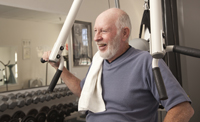
Those of us who work in health and wellness have a tremendous opportunity before us to positively influence the health of well over 100 million aging Americans. The “Baby Boomer and beyond” demographic needs solutions for ongoing health issues—and this group is looking for them.
The Centers for Disease Control and Prevention reports that 80% of adults ages 65-plus have at least one chronic health issue and, according to the World Health Organization, this age group spends more on health than anything else. (Consider: One market research firm estimated that this group would invest more than 72 billion dollars in 2009, in an effort to hold back time.) Boomers face epidemics of diabetes, Alzheimer’s disease and other conditions in the coming years. In fact, they are already reporting more disabilities than in the past, reveals a recent study to be published in the American Journal of Public Health. Not surprisingly, the goal of most aging adults today is to prevent, delay, manage or improve health conditions, so they can remain independent and active in society.
Older adults already know that regular physical activity is good for their health. Although health is a key concern for them and something they are willing to invest in, there have been statistically insignificant improvements in the levels of physical activity among age 65-plus adults in the last 10 years.(5)
Maybe it's time to rethink how we market physical activity to an older audience. The 2008 Physical Activity Guidelines for Americans offers a tool we can use to market physical activity as the foundation for active, independent aging and a solution for chronic health issues. To do this, we need to understand that “Nearly half of the Baby Boom Generation believes there is little truth in advertising and more than 60% wish ads had more real information, suggesting that America's advertising industry may be missing the mark in targeting the most affluent generation in U.S. history.”
What do we have to do differently to get a better result? The following are a few recommendations for how we can start marketing efforts that reach and resonate with older Americans:
1. Become a student of the market before you start marketing to them. Learn about their needs, desires, dreams and expectations.
2. Speak their language and not ours.
3. Build a relationship.
4. Tell a story.
5. Keep it real by using peer role models.
Using the Physical Activity Guidelines, we can be specific in our messaging and recommendations, as well as share the facts. Finally, and perhaps most importantly, we can share what a physically active lifestyle really means. Aging actively is about having solutions to health issues; spending less on healthcare and medications; keeping involved in life; staying independent; being able to go on trips; protecting mind, body and spirit; aging at home; spending time with grandkids; and much, much more. It’s about the ability to live life fully at any age.
What has been your organization’s success factor in promoting physical activity to older individuals?





